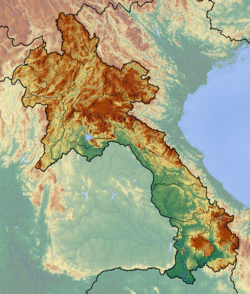Portal:Laos
Portal:Laos/Intro
Laos (/ˈlɑːoʊs/ , /ˈlaʊs/, /ˈlɑːɒs/, or /ˈleɪɒs/; Lao: ລາວ, Lao pronunciation: [láːw], Lāo), or commonly referred to its colloquial name of Muang Lao (Lao: ເມືອງລາວ, Muang Lao), is a landlocked country in the heart of the Indochinese peninsula of Mainland Southeast Asia, bordered by Myanmar (Burma) and China to the northwest, Vietnam to the east, Cambodia to the southwest, and Thailand to the west and southwest. It traces its historic and cultural identity to the kingdom of Lan Xang Hom Khao (Kingdom of a Million Elephants Under the White Parasol), which existed for four centuries as one of the largest kingdoms in Southeast Asia. Due to Lan Xang's central geographical location in Southeast Asia, the kingdom was able to become a popular hub for overland trade, becoming wealthy economically as well as culturally. After a period of internal conflict, Lan Xang broke off into three separate kingdoms — Luang Phrabang, Vientiane, and Champasak. In 1893, it became a French protectorate, with the three territories uniting to form what is now known as the country of Laos. It briefly gained freedom in 1945 after Japanese occupation, but was recolonised by France until it won autonomy in 1949. Laos became independent in 1953 under King Sisavang Vong. The capital city is Vientiane. Other large cities include Luang Prabang, Savannakhet, and Pakse. The official language is Lao. Laos is a multi-ethnic country with the politically and culturally dominant Lao people making up approximately 60 percent of the population, mostly in the lowlands. Mon-Khmer groups, the Hmong, and other indigenous hill tribes, accounting for 40 percent of the population, live in the foothills and mountains. Laos' ambitious strategies for development are based on generating electricity from its rivers and selling the power to its neighbors, namely Thailand, China, and Vietnam, as well as its initiative to become a 'land-linked' nation, shown by the planning of four new railways connecting Laos to those same countries. This, along with growth of the mining sector, Laos has been referred to as one of East Asia and Pacific's fastest growing economies by the World Bank, with annual GDP growth averaging 7% for the past decade. It is a member of the Asia-Pacific Trade Agreement (APTA), Association of Southeast Asian Nations (ASEAN), East Asia Summit and La Francophonie. Laos became a member of the World Trade Organization (WTO) in 2013. Selected article - General images -The following are images from various Laos-related articles on Wikipedia.
Related portalsSoutheast Asia Other Countries Selected biography -Nang Keo Phimpha (Lao: ນາງແກ້ວພິມພາ) (1343–1438), an epithet meaning literally "The Cruel", was Queen regnant of Lan Xang in 1438, taking the regnal name Samdach Brhat-Anya Sadu Chao Nying Kaeva Bhima Fa Mahadevi(Lao: ສົມເດັຈ ພຣະຍາ ສາທຸເຈົ້າຍິງ ແກ້ວພິມພາມະຫາເທວີ). She is also known by her title Maha Devi, and may have been the only reigning female sovereign of the kingdom of Lan Xang. According to some chronicles, she briefly occupied the throne for a few months, before she was deposed and killed at ninety-five years old. Her brief reign was the culmination of a ten-year period of regicide, which she orchestrated through a series of puppet kings. The true identity of the Maha Devi is a matter of dispute both in the chronicles of later periods, and among current scholars. She has variously been described as the eldest daughter, younger sister, principal wife, or step-mother of Samsenthai. Of the few solid clues to her identity, her title as Maha Devi or "Great Goddess," was reserved for only the senior queen of a ruling monarch. Scholars including Martin Stuart-Fox and Amphay Dore, point out that both her age at the time of execution and title as Maha Devi indicate her true identity to be Keo Lot Fa the Queen Consort of Fa Ngum from Ayutthaya who would have assumed the title of Maha Devi after the death of Queen Keo Kang Nya in 1368, shortly before Fa Ngum was deposed in 1371. Although her identity remains a mystery, the consensus among the royal chronicles remains that she was the de facto ruler during a brutal succession dispute between court factions from the death of Lan Kham Deng to the accession of Chakkaphat Phaen Phaeo. (Full article...)Selected picture View of Pha That Luang, Vientane. WikiProjects
TopicsCategoriesDid you know?
Tasks
Associated WikimediaThe following Wikimedia Foundation sister projects provide more on this subject:
ContributorsDiscover Wikipedia using portals | |||||||||
































































